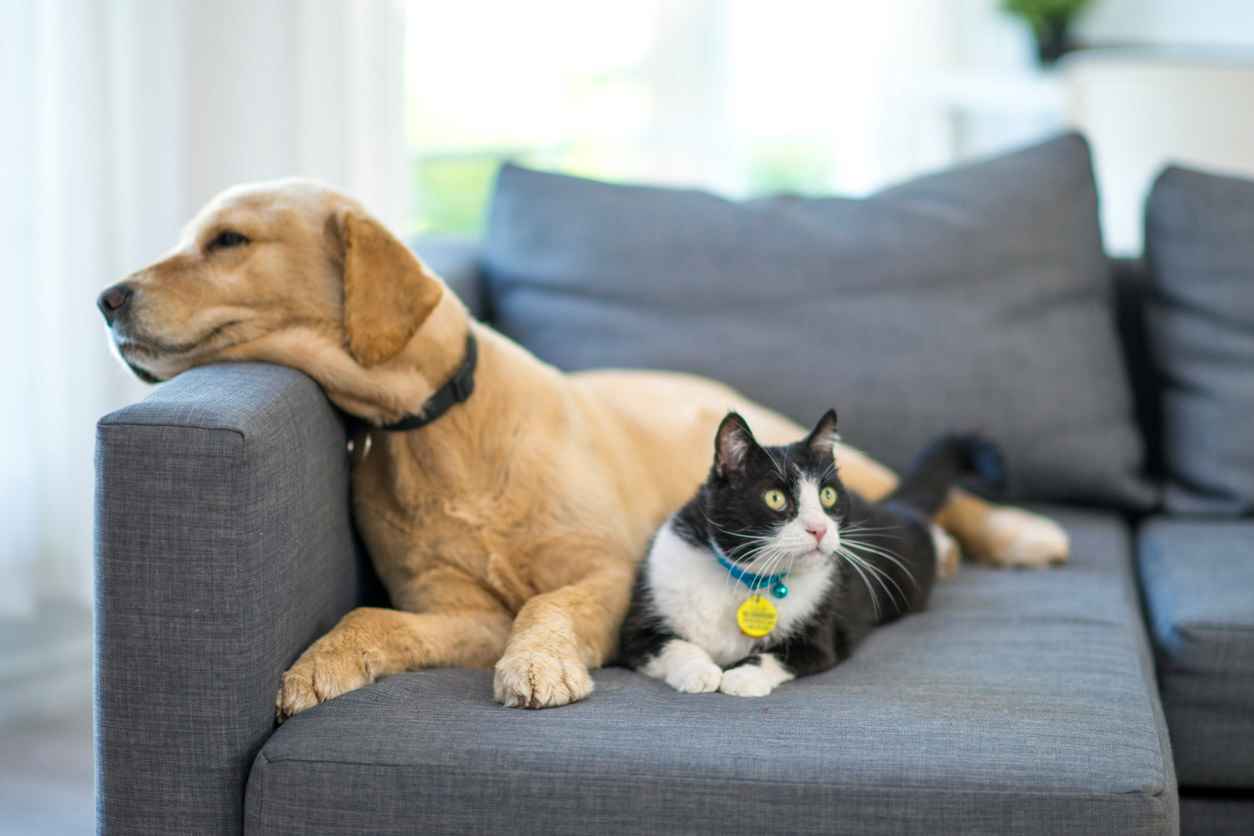We put measures in place to prepare financially for unforeseen events that could affect our assets like our homes and our cars.
So, what about our pets? If your furry friend becomes sick or injured unexpectedly, have you considered what options are available to help cover the treatment cost?
What are the treatment costs for common pet health conditions?
Let’s consider a common health condition for a cat and a dog, and the associated treatment costs for each species based on PetSure claims data#:
Firstly, if you had a three-year-old Ragdoll cat with feline lower urinary tract disease, this would typically require on average three vet visits. The average annual cost for veterinary treatment for this condition would be $1,482.#.
As a second example, if you had a three-year-old female Cavoodle that experiences a gastrointestinal tract infection and an allergic skin condition in a 12-month period this would generally involve an average of six vet visits. The average annual average cost of veterinary treatment for these conditions would be $2,169, based on PetSure claims data#.
What are some of my options to cover costs?
Based on the two scenarios above and the associated treatment costs, we review some of the options available to help cover pet healthcare expenses.
1. Pet insurance
Pet insurance may help relieve some of the financial pressure of vet bills if your fur baby gets unexpectedly sick or injured. Many policies pay up to 80% of the eligible vet bills up to the value of $10,000 or more each year.
If you use PetSure’s Find a policy tool, you can find a provider and click through to generate a quote. The following includes a specific example of what you might expect to pay for an annual premium.
Ragdoll: if you purchased a comprehensive accident & illness cover policy* for your cat at the beginning of the year, for example, your pet insurance premium would be around $27.88 per month or $334.56 annually*.
For an eligible condition, a PetSure administered policy such as the one quoted above, would reimburse up to 80% of the vet bill, so for your Ragdoll’s urinary tract disease (average cost of $1,482), your out-of-pocket expense would be $296.40. Combining your out-of-pocket cost with your annual pet insurance premium, the total pet health expense for this scenario would be $630.96.
Cavoodle: if you purchased the same comprehensive accident & illness cover policy** for your dog at the start of the year, you’d pay $41.77 per month or $501.24 annually**.
Similarly, the vet bill for your Cavoodle for a gastrointestinal tract infection (at an average cost of $2,169) would have an out-of-pocket expense of around $433.80 for an eligible condition where your pet insurance policy covered up to 80% of the cost. Add your out-of-pocket treatment expense to your annual premium and your total estimate cost would be around $935.04.
PetSure is the only pet insurance administrator in Australia to offer GapOnly®, an innovative payment solution that allows the customer to simply pay the gap^, to minimise upfront out-of-pocket expenses while still at the vet clinic.
There are other options you could consider to help cover the vet expense of $1,482 for your Ragdoll’s treatment or $2,169 for your Cavoodle’s treatment in the illustrative examples highlighted. These payment options are outlined below.
2. Credit card payments
A credit card payment allows a customer to make a purchase and complete other transactions using money borrowed from the card issuer, such as a bank. In some cases, a credit card could be an alternative to pet insurance.
According to the Reserve Bank of Australia (RBA), a credit card’s typical annual interest rate charge is 17.93%##. In addition, some lenders also charge annual fees, late fees and over-limit fees but for illustrative purposes, we’ll just show an example of the monthly repayment calculation.
Ragdoll:
For a balance of $1,482 at an interest rate of 17.93%##, if you made a higher repayment of $135 per month, you’d pay a total of $1,605 over 12 months, without including any additional fees that may be charged by the lender. This calculation is from the Moneysmart.gov.au credit card calculator^^.
Cavoodle:
To repay a balance of $2,169 at 17.93% interest, if you made a higher repayment of $210 per month, you’d pay a total of $2,335 over a year^^, without factoring in any additional fees charged by the bank.
3. Consider a personal loan
A personal loan (What Is A Personal Loan? Types Of Personal Loans | Canstar) allows a customer to borrow a specific amount of money, and then repay the money plus interest over the agreed term, according to Canstar. While personal loan interest rates vary dramatically, the RBA says the average rate in Australia for August 2023 was 7.80%~.
Again, doing a similar calculation using the Moneysmart.gov.au personal loan repayment calculator.
Ragdoll:
To repay a principal of $1,482 for a 12-month term, the monthly repayment at an average interest rate of 7.8% would be $129, so a total estimate annual cost of $1,548 in loan repayments^^^ based on the Moneysmart’s personal loan repayment calculator.
Cavoodle:
To borrow $2,169 over 12 months at 7.8% interest, the monthly repayment would be $188, so a total estimated total repayment cost of $2,256^^^.
There may be additional application fees for a personal loan, which have not been included in the above calculation.
4. A savings or transaction account
A savings account could be a good addition or alternative to pet insurance, if you are diligent with regular savings payments and are willing to draw on funds as needed to cover large and unexpected pet healthcare costs.
You could open a dedicated savings or transaction account for your pet’s medical expenses. If you contribute regularly, you’ll have money set aside when you need it, but remember it takes time to grow your savings and it can be tempting to dip into savings when other expenses occur and cost of living rises, such as household expenses like groceries, electricity and petrol.
So, when reviewing payment options, consider how you’ll fund ongoing care throughout your pet’s life, not just one-off or annual costs, because pets are living longer+.
Remember pets can encounter health issues at any age. For instance, while young pets may be more prone to congenital conditions and accidents while middle-aged pets could be at risk of weight issues and older animals face greater risk of conditions like arthritis and cancer.
There are many options available to help you cover pet healthcare costs and provide some financial cushioning when things don’t go to plan. Being financially prepared, and taking action early during your pet’s life, means you won’t have to make difficult decisions about your pet’s health or treatment plan based solely on cost.
References:
*Based on a 32-year-old pet owner living in postcode 2099 with cover provided by PetSure’s direct brand petinsurance.com.au (Best in Show: Gold Cover) with a $250 excess. The quote generated was for a desexed three-year old female Ragdoll on 15 November 2023. These quotes are examples only. Actual prices and coverage will vary. You should consider the Product Disclosure Statement to determine which products are appropriate for you.
** Based on a 32-year-old pet owner living in postcode 2099 with cover provided by PetSure’s direct brand petinsurance.com.au (Best in Show: Gold Cover) with a $250 excess. The quote generated was for a desexed three-year old female Cavoodle on 15 November 2023. These quotes are examples only. Actual prices and coverage will vary. You should consider the Product Disclosure Statement to determine which products are appropriate for you.
^The gap means the difference between the vet’s invoice and the eligible claim benefit under your policy.
# Financial year 2023 PetSure data. Average annual cost reflects the average cost across all vet visits.
## According to RBA data, the average credit card interest rate is 17.93% for the month ending August – https://www.rba.gov.au/statistics/tables/
^^Calculated using the MoneySmart credit card calculator:
https://moneysmart.gov.au/credit-cards/credit-card-calculator
^^^ Calculated using the MoneySmart personal loan calculator:
https://moneysmart.gov.au/loans/personal-loan-calculator
~ Reserve Bank of Australia, personal lending rates –
total lending rates, personal credit, outstanding, fixed-term loans, August 2023
+ According to Qrillpet.com.
Insurance products are issued by The Hollard Insurance Company Pty Ltd ABN 78 090 584 473, AFSL 241436 (Hollard) and/or PetSure (Australia) Pty Ltd ABN 95 075 949 923, AFSL 420183 (PetSure) (from 8 May 2023 only), administered by PetSure and promoted and distributed through their authorised representatives and distribution partners.
Any advice provided is general only and does not take into account your individual objectives, financial situation or needs. Cover is subject to the policy terms and conditions. Please consider the Product Disclosure Statement (PDS) to ensure this product meets your needs before purchasing or choosing to continue with the product. PDS and Target Market Determination available on our partners’ websites. Meet our partners at petsure.com.au/partners.
Pet insurance can help by covering a portion of the eligible vet bill if the unexpected happens. Because it is difficult to predict the costs of veterinary care, it can help to have measures in place to help prepare for the unexpected. Check out our partner network and explore our policy tools to find a pet insurance policy.
Not all conditions or items are covered by Pet Insurance. Refer to the applicable Product Disclosure Statement for information about coverage and exclusions.








